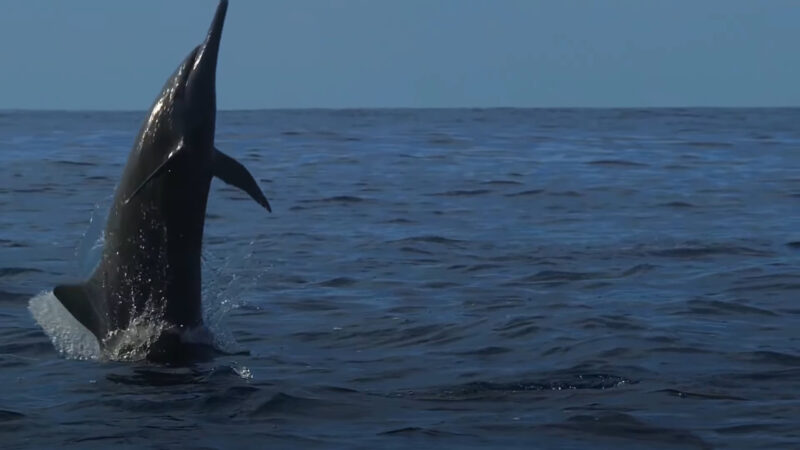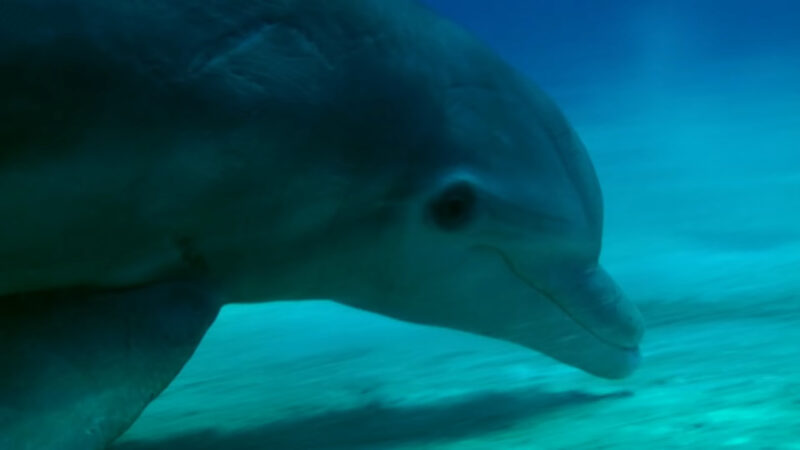Dolphins are known for their playful nature and impressive acrobatics. They often leap out of the water, demonstrating remarkable agility and strength.
This behavior, called breaching, involves dolphins using their tail flukes to propel themselves over 25 feet into the air. But why do they do this?
The reasons range from practical purposes like navigation and communication to simple playfulness.
Key highlights:
- Dolphins use jumping or breaching primarily for communication, navigation, and health, including signaling their location, gaining a better view of their surroundings, and dislodging parasites.
- Breaching is an energy-efficient way of traveling long distances at high speeds, and it helps dolphins in thermoregulation by releasing excess body heat.
- Social bonding and playfulness are significant reasons for dolphins’ jumping behavior, enhancing group cohesion and providing cognitive and emotional benefits.
- The physical mechanics of a dolphin’s leap, involving muscular strength and aerodynamic design, are crucial for achieving the impressive heights and agility seen in these actions.
- Dolphins’ jumping behavior is an indicator of their intelligence and adaptability, reflecting their complex relationship with the marine ecosystem and their role as key indicators of ocean health.
Dolphin Behavior

Dolphins’ ability to jump high out of the water is a combination of their muscular power and hydrodynamic design. These mammals‘ tail flukes provide the necessary thrust, while their streamlined bodies allow them to cut through the water with minimal resistance.
This makes breaching an efficient movement despite its high energy cost.
Jumping for Communication
- Signaling Location: Dolphins use breaching as a means of communication. By leaping out of the water, they create a loud sound upon re-entry, which can be heard for miles underwater. This is known as beach casting and is a way for dolphins to signal their location to other dolphins.
- Warning Against Predators: Jumping can also serve as a warning signal against predators. By breaching, dolphins can alert their group to potential dangers lurking nearby.
Health and Hygiene
Parasite Removal
Dolphins jump out of the water to dislodge parasites. The impact of hitting the water helps remove these unwanted hitchhikers, contributing to the dolphin’s overall health and well-being.
Navigational Aids
- Increased Visibility: One practical reason dolphins jump is to get a better view of their surroundings, known as spy-hopping. This increased visibility is crucial for hunting and navigating through complex environments.
- Spy-Hopping for Prey: By jumping, dolphins can locate schools of fish more effectively. Their acute sense of hearing aids in pinpointing the location of prey, and breaching gives them a better vantage point.
Energy Conservation
Efficient Travel
Contrary to what one might think, jumping can be an energy-efficient way of traveling. By leaping out of the water, dolphins can cover large distances at high speeds with less effort compared to swimming.
Thermoregulation
Dolphins regulate their body temperature through breaching. Jumping into the air and exposing their bodies to the atmosphere helps them release excess heat, maintaining a healthy body temperature.
The Joy of Jumping

Playfulness and Fun
Dolphins are inherently playful creatures. They often jump for sheer enjoyment, entertaining themselves and onlookers.
This playfulness is an essential part of their social structure and mental health.
Performing Tricks
Dolphins are known to perform tricks while jumping, spinning, and flipping in the air. This is not just for entertainment but also a way to strengthen social bonds within their groups.
Analysis of Breaching
Knowing the physical mechanics behind a dolphin’s leap is crucial. Dolphins are built for speed and agility. Their muscular structure, particularly in the tail and dorsal areas, provides the necessary force for a powerful breach.
The physics of this movement is a combination of speed, angle of launch, and muscle power. The aerodynamics of their sleek body shape reduces drag, allowing them to slice through the air with ease.
Communication Through Acrobatics
- Long-Distance Messaging: Dolphins’ breaching can be a form of long-distance communication. The sound of their bodies hitting the water surface can travel vast distances, serving as a beacon for separated pod members or as a warning signal.
- Social Bonding: Breaching also plays a role in social bonding. Dolphins in a group often synchronize their jumps, which strengthens social ties and establishes group cohesion. These synchronized jumps can be a display of strength, coordination, and unity.
Navigation and Hunting Strategies

Leveraging Height for Hunting
From a higher vantage point, dolphins can spot schools of fish more efficiently. This advantage is crucial in open waters where visibility is limited.
By breaching, dolphins gain a brief but vital aerial view, aiding them in tracking prey movements.
Avoiding Predators
Dolphins also use breaching as a strategy to evade predators. The sudden burst of speed and change in direction can disorient predators, giving dolphins a better chance of escape.
Health Benefits of Jumping
The impact of water helps exfoliate the dolphin’s skin, keeping it free from parasites and dead cells. This natural grooming process is essential for their health, as clean skin reduces drag and increases swimming efficiency.
Energy Dynamics in Breaching
While breaching requires a burst of energy, the process of jumping and gliding through the air can be more energy-efficient than continuous swimming, especially over long distances. This is because air offers less resistance than water, allowing dolphins to cover greater distances with less effort.
The Playful Nature
Play is a crucial aspect of dolphins’ cognitive and emotional development. Through playful jumping, dolphins explore their environment, develop motor skills, and engage in creative problem-solving.
This behavior also has a positive effect on their mental health, reducing stress and encouraging positive social interactions.
The Role in Marine Ecosystems
Understanding why dolphins jump is not just about the behavior itself but also about recognizing their role in the marine ecosystem. Dolphins are key indicators of ocean health. Their behaviors, including jumping, can provide valuable insights into the state of the marine environment.
FAQs
How do young dolphins learn to jump?
They learn to jump primarily through imitation. They observe and mimic the actions of adults in their pod, gradually developing the skill and strength required for jumping.
Can all dolphin species jump out of the water?
Most species are capable of jumping out of the water. However, the ability and frequency of jumping can vary widely among species, depending on their size, habitat, and social behaviors.
Do dolphins jump more frequently in certain seasons or weather conditions?
They may jump more frequently in certain conditions, such as calm seas, which make it easier to spot prey or communicate.
However, there’s no specific season universally known for increased jumping activity as it largely depends on the local environment and species.
Is jumping ever used by dolphins to escape from predators?
Yes, they sometimes use jumping as an escape mechanism.
The sudden burst of speed and change in direction can help them evade predators like sharks.
How does jumping affect a dolphin’s energy levels?
While jumping requires a significant amount of energy, these animals are highly efficient swimmers, and their streamlined bodies reduce the energy cost.
The trade-off between energy expenditure and the benefits of jumping, like hunting or communication, is typically favorable.
Can breaching be a sign of distress in dolphins?
In rare cases, repeated, frantic breaching can be a sign of distress. This might be due to disorientation, illness, or escape attempts from predators or human-induced disturbances.
However, it’s essential to evaluate other behaviors and contexts to understand the reason accurately.
Final Words
Dolphins’ ability to leap out of the water is a multifaceted behavior. It serves practical purposes like communication, navigation, hygiene, and energy conservation.
But it’s also a reflection of their playful nature, a testament to their intelligence and social complexity. Knowing these reasons enhances our appreciation of these remarkable creatures and their place in the marine ecosystem.
In a nutshell, dolphins jump out of the water for a variety of reasons: for fun, increased visibility, parasite removal, improved navigation, and as a form of communication. This behavior showcases their incredible adaptability and intelligence, making them one of the most fascinating creatures in the ocean.








